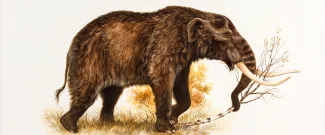
Mammals traveling exhibition in 2014.
Mammoth or mastodon? Many people use these two names interchangeably to describe big, furry ice age elephants. However, while both are distantly related to elephants, these two animals are distinctly different beasts. The ancestors of the American mastodon split away from the mammoths sometime around 25 million years ago. They eventually crossed Beringia, eastward from Asia, around 15 million years ago. As its name suggests, the American mastodon evolved in North America, some 3.5 million years ago. Even though it never made the return journey back into Asia, the American mastodon had an incredibly wide geographic range during the Ice Age, stretching from Arctic Alaska to the tropics of Honduras!
A few key features can help distinguish a mastodon from a mammoth. Both superficially look like furry elephants, but mastodons were slightly shorter and had a stockier build. Mastodon tusks are shorter and straighter than those of their mammoth cousins. Probably the most significant difference is the shape and function of their molars. Mammoth molars have a nearly flat surface, used for grinding and sheering grass. American mastodon molars are distinguished by low, rounded cusps covered in hard enamel that formed a pair of rows. These teeth were great for snapping and chewing branches of shrubs and small trees. In essence, a mammoth was a grazer, while a mastodon was a browser. Think cattle (mammoth) versus moose (mastodon).
Yukon's Mastodon History
Unlike Yukon's abundant record of mammoths, mastodon fossils are rarely found in Yukon. Approximately 95 percent of the ancient "elephant" fossils in Yukon are from mammoths. A few isolated mastodon molars have been recovered from the Klondike placer mines and along the Old Crow River, and a single foot bone was found all the way up on Herschel Island.
Because mastodon fossils are so rare in Yukon, it was a great surprise when Mr. Earl Bennett donated a partial mastodon skeleton to the Yukon Palaeontology Program! The skeleton included several limb bones, shoulder blades, vertebra, and jaws with molars. It was discovered by a crew working on Bonanza Creek in the early 1970s. It is the most complete example of an American mastodon ever found in Yukon.
Want to keep exploring? Check out the Beringia Research Notes on the American mastodon.

Mastodon molars look surprisingly similar to some human molars, albeit giant versions. Some early collections of American mastodon molars that were sent to scientists in France in the 18th century were described as the teeth of giant people!

